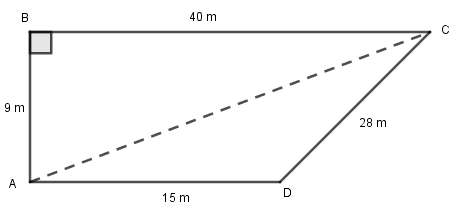
Find the area of the quadrilateral whose sides are 9 m, 40 m, 28 m, 15 m. The angle between the first two sides is ${90^ \circ }$.
A. 348 $m^2$
B. 315 $m^2$
C. 306 $m^2$
D. None of these
Answer
573.9k+ views
Hint: In the above question, we need to draw a diagonal in the quadrilateral which divides the quadrilateral into two triangles. In the first triangle, whose angle is ${90^ \circ }$ we will use the formula $\dfrac{1}{2} \times base \times height$. Then we will use the Pythagoras theorem to find the length of the diagonal. Then we will try to find the area of the second triangle by using the formula $\sqrt {s(s - a)(s - b)(s - c)} $. Then finally we will add the area of both the triangles to get the area of quadrilateral.
Complete step-by-step answer:
Let ABCD be a quadrilateral drawn in figure below.

AB = 9 m, BC = 40 m, CD = 28 m, DA = 15 m and $\angle ABC = {90^ \circ }$
Area of quadrilateral ABCD = Area of $\vartriangle ABC$ + Area of $\vartriangle ACD$
In $\vartriangle ABC$, using the Pythagoras theorem,
$A{C^2} = A{B^2} + B{C^2}$
$ \Rightarrow AC = \sqrt {{{\left( 9 \right)}^2} + {{\left( {40} \right)}^2}} = \sqrt {1681} = 41$m
Area of triangle ABC $ = \dfrac{1}{2} \times AB \times BC$
$ = \dfrac{1}{2} \times 9 \times 40 = 180 {m^2}$
Finding area of triangle ACD using heron’s formula
Area of triangle ACD $ = \sqrt {s(s - a)(s - b)(s - c)} $
where $s = \dfrac{{a + b + c}}{2} = \dfrac{{15 + 28 + 41}}{2} = 42$m, a = 15 m, b = 28 m, c = 41 m.
Now putting the value of s in the above formula.
Area of triangle ACD $ = \sqrt {42(42 - 15)(42 - 28)(42 - 41)} $
$ = \sqrt {42 \times 27 \times 14 \times 1} = 126 {m^2}$
The area of quadrilateral ABCD = Area of triangle ABC + Area of triangle ACD
Thus, the area of quadrilateral ABCD = 180 + 126 = $306 {m^2}$
So, the correct answer is “Option C”.
Note: A method for calculating the area of a triangle when we have the length of all the three sides. Let a, b, c be the lengths of the sides of a triangle. Then Area $ = \sqrt {s(s - a)(s - b)(s - c)} $ This formula is also known as Heron’s Formula.
Alternatively, you can use Heron’s formula for any type of triangle in which all sides are given, i.e. also for the right triangle.
Complete step-by-step answer:
Let ABCD be a quadrilateral drawn in figure below.

AB = 9 m, BC = 40 m, CD = 28 m, DA = 15 m and $\angle ABC = {90^ \circ }$
Area of quadrilateral ABCD = Area of $\vartriangle ABC$ + Area of $\vartriangle ACD$
In $\vartriangle ABC$, using the Pythagoras theorem,
$A{C^2} = A{B^2} + B{C^2}$
$ \Rightarrow AC = \sqrt {{{\left( 9 \right)}^2} + {{\left( {40} \right)}^2}} = \sqrt {1681} = 41$m
Area of triangle ABC $ = \dfrac{1}{2} \times AB \times BC$
$ = \dfrac{1}{2} \times 9 \times 40 = 180 {m^2}$
Finding area of triangle ACD using heron’s formula
Area of triangle ACD $ = \sqrt {s(s - a)(s - b)(s - c)} $
where $s = \dfrac{{a + b + c}}{2} = \dfrac{{15 + 28 + 41}}{2} = 42$m, a = 15 m, b = 28 m, c = 41 m.
Now putting the value of s in the above formula.
Area of triangle ACD $ = \sqrt {42(42 - 15)(42 - 28)(42 - 41)} $
$ = \sqrt {42 \times 27 \times 14 \times 1} = 126 {m^2}$
The area of quadrilateral ABCD = Area of triangle ABC + Area of triangle ACD
Thus, the area of quadrilateral ABCD = 180 + 126 = $306 {m^2}$
So, the correct answer is “Option C”.
Note: A method for calculating the area of a triangle when we have the length of all the three sides. Let a, b, c be the lengths of the sides of a triangle. Then Area $ = \sqrt {s(s - a)(s - b)(s - c)} $ This formula is also known as Heron’s Formula.
Alternatively, you can use Heron’s formula for any type of triangle in which all sides are given, i.e. also for the right triangle.
Recently Updated Pages
Why are manures considered better than fertilizers class 11 biology CBSE

Find the coordinates of the midpoint of the line segment class 11 maths CBSE

Distinguish between static friction limiting friction class 11 physics CBSE

The Chairman of the constituent Assembly was A Jawaharlal class 11 social science CBSE

The first National Commission on Labour NCL submitted class 11 social science CBSE

Number of all subshell of n + l 7 is A 4 B 5 C 6 D class 11 chemistry CBSE

Trending doubts
What is meant by exothermic and endothermic reactions class 11 chemistry CBSE

10 examples of friction in our daily life

One Metric ton is equal to kg A 10000 B 1000 C 100 class 11 physics CBSE

1 Quintal is equal to a 110 kg b 10 kg c 100kg d 1000 class 11 physics CBSE

Difference Between Prokaryotic Cells and Eukaryotic Cells

What are Quantum numbers Explain the quantum number class 11 chemistry CBSE




